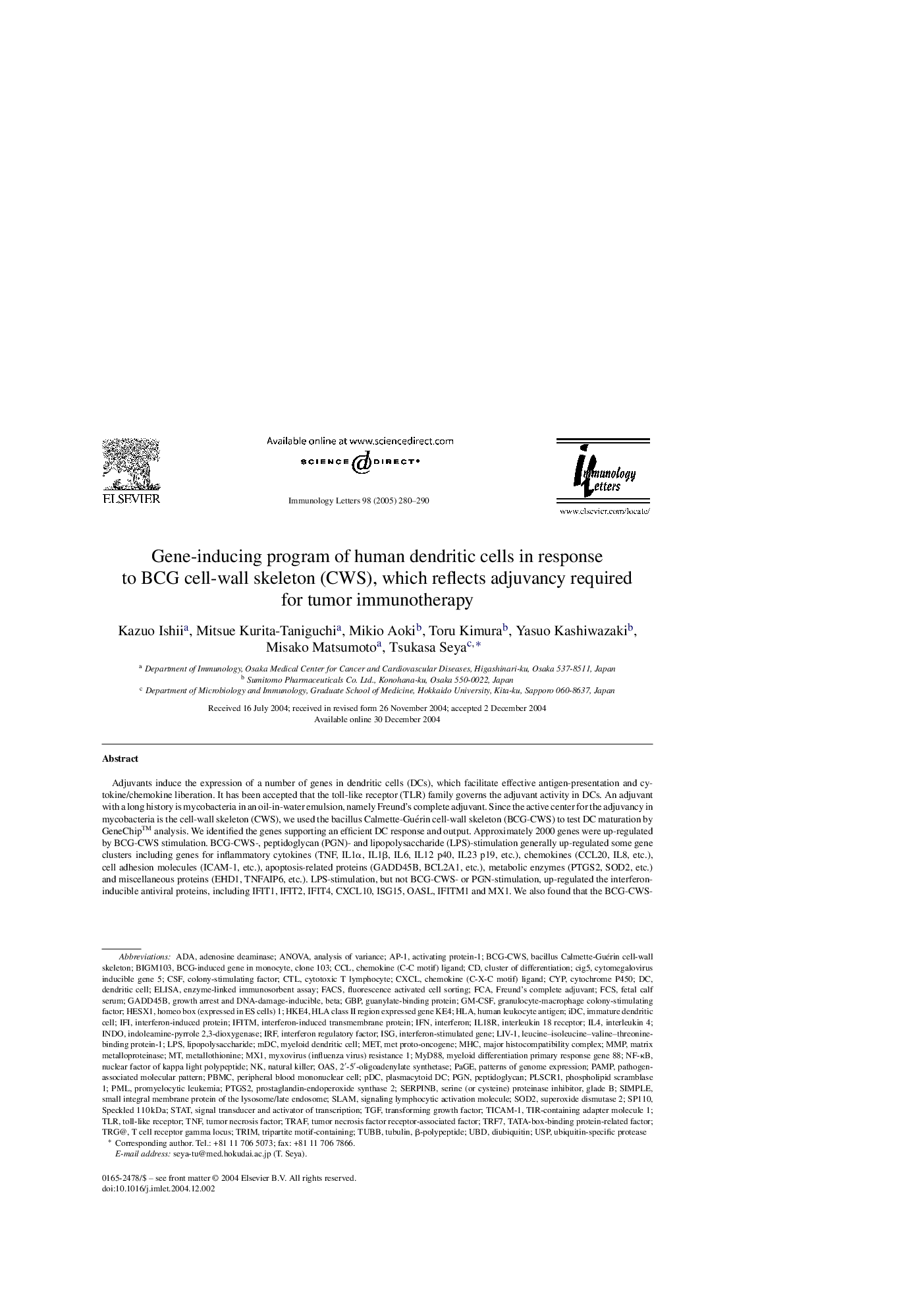| Article ID | Journal | Published Year | Pages | File Type |
|---|---|---|---|---|
| 9266238 | Immunology Letters | 2005 | 11 Pages |
Abstract
Adjuvants induce the expression of a number of genes in dendritic cells (DCs), which facilitate effective antigen-presentation and cytokine/chemokine liberation. It has been accepted that the toll-like receptor (TLR) family governs the adjuvant activity in DCs. An adjuvant with a long history is mycobacteria in an oil-in-water emulsion, namely Freund's complete adjuvant. Since the active center for the adjuvancy in mycobacteria is the cell-wall skeleton (CWS), we used the bacillus Calmette-Guérin cell-wall skeleton (BCG-CWS) to test DC maturation by GeneChip⢠analysis. We identified the genes supporting an efficient DC response and output. Approximately 2000 genes were up-regulated by BCG-CWS stimulation. BCG-CWS-, peptidoglycan (PGN)- and lipopolysaccharide (LPS)-stimulation generally up-regulated some gene clusters including genes for inflammatory cytokines (TNF, IL1α, IL1β, IL6, IL12 p40, IL23 p19, etc.), chemokines (CCL20, IL8, etc.), cell adhesion molecules (ICAM-1, etc.), apoptosis-related proteins (GADD45B, BCL2A1, etc.), metabolic enzymes (PTGS2, SOD2, etc.) and miscellaneous proteins (EHD1, TNFAIP6, etc.). LPS-stimulation, but not BCG-CWS- or PGN-stimulation, up-regulated the interferon-inducible antiviral proteins, including IFIT1, IFIT2, IFIT4, CXCL10, ISG15, OASL, IFITM1 and MX1. We also found that the BCG-CWS- or PGN-stimulation up-regulated CXCL5, MMP1, etc. We discussed their properties in association with TLRs and recently discovered TLR adapters.
Keywords
NF-κBMMPFACSLPSPBMCCTLIDCCyPMYD88GBPPDCPMLPAGEFCSMDCAP-1PAMPTLRTGFGM-CSFSOD2CCLPtgs2IFICXCLHESX1IRFISGTRIMTRAFUSPGadd45bPGNIL4Plasmacytoid DCindoleamine-pyrrole 2,3-dioxygenaseIFITMSP110UbDTICAM-1BCG-CWSDiubiquitinLIV-1TNFmet proto-oncogene2′-5′-oligoadenylate synthetasePLSCR1natural killerMx1adenosine deaminaseSTATHuman leukocyte antigenHLASLAMpathogen-associated molecular patternimmunotherapyinterferonIFNInterleukin 4transforming growth factoranalysis of varianceANOVAELISAEnzyme-linked immunosorbent assayTUBBToll-like receptorcluster of differentiationMicroarraySIMPLEfetal calf serumPeripheral blood mononuclear cellDendritic cellImmature dendritic cellDendritic cellsMyeloid dendritic cellSuperoxide dismutase 2Cytochrome P450interferon regulatory factorgranulocyte-macrophage colony-stimulating factortumor necrosis factor receptor-associated factorColony-stimulating factortumor necrosis factorFcaPhospholipid scramblase 1activating protein-1fluorescence activated cell sortingcytotoxic T lymphocytePromyelocytic leukemiachemokine (C-C motif) ligandlipopolysaccharidechemokine (C-X-C motif) ligand matrix metalloproteinaseCSFSignal transducer and activator of transcriptionMHCmajor histocompatibility complexMETsignaling lymphocytic activation moleculeindoOASADAmyeloid differentiation primary response gene 88ubiquitin-specific proteaseguanylate-binding proteinprostaglandin-endoperoxide synthase 2Peptidoglycaninterferon-stimulated geneFreund's complete adjuvant
Related Topics
Life Sciences
Immunology and Microbiology
Immunology
Authors
Kazuo Ishii, Mitsue Kurita-Taniguchi, Mikio Aoki, Toru Kimura, Yasuo Kashiwazaki, Misako Matsumoto, Tsukasa Seya,
